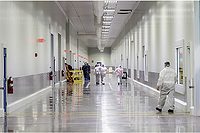Field Reports
Put a chill on flour, and waste
Using cryogenics to cool flour in the mixing process allows this bakery to cut waste and boost quality.


|
| The multi-point CO2 injection system uses specially designed nozzles to chill fast-moving flour to within -/+1°F of the set point for high consistency and repeatability at the mixer. Inset: Linde CO2 tank (left) and flour silo (right). Source: Linde NA. |
Cold processing is critical to Coles’ product quality and coast-to-coast success. But increasing demand for Coles unique frozen breads tested the company’s production operations in the summer of 2012.
“The driving force for us wanting to make a change was extrusion quality,” says Aaron Scott, plant manager of Coles baking and freeze processing facility in North Liberty, IA.
After dough is mixed and processed through the extrusion systems, Coles proofs product prior to baking, then applies the toppings. Next, the breads move by conveyor to a Linde cryogenic spiral freezer for a highly controlled freeze with carbon dioxide (CO2). “The spiral works well for the volumes we are running,” says Scott. “But we were experiencing issues with the dough going into our extrusion and finishing operations.” Coles reached out to Linde North America for an assessment.
The plant performs continuous quality control and samples product hourly to monitor processes. Problems with the dough can be visible, especially during and after extrusion operations. “We need to discard [imperfect] product before it goes through the applicator and into the spiral,” explains Scott. “That can slow you down. And no one likes to discard product, because at that point, you’ve lost not only the ingredients, but all the overhead that went into production.”
Following the in-plant assessment, the Linde food team recommended an inline cryogenic flour chilling system to achieve more consistent dough mixing performance. Like many well-established bakeries, the plant had relied on chilling the mixer with ice in warmer weather, particularly from May to October. An operator would retrieve two 25-pound bags of ice from a machine (one flight down) and pour it into the 1,000-pound Peerless mixer, with a new mixing cycle every 20 to 30 minutes. First, the dry ingredients would be added and then the liquids, with the water portion of the recipe adjusted down to compensate for the ice.
The Linde system injects liquid CO2 into the pneumatic system as flour is conveyed to the mixer from an outdoor silo through a four-inch line. The temperature of the flour is continuously monitored just before the inlet to the mixing vessel; a feedback system controls the precise injection of CO2 to ensure a consistent flour temperature to within -/+1°F of the set point. The precision feedback system also minimizes cryogen use to keep operating costs low.
Linde installed the chilling system, including all supply lines and venting, over an extended holiday weekend (Friday-Sunday) and trained the staff on the system’s operation and safety on Monday. The use of cryogenics takes advantage of the existing CO2 supply (used to freeze the final product in a cryogenic spiral freezer) and provides improved mixer operation, eliminating all the variations associated with ice chilling. Product losses were reduced 0.2 percent—significant in a high-volume operation like the one at Coles. Plus, since the installation, there is no ice to carry, eliminating a worker safety issue.
Cryogenic control of incoming flour temperatures can also mean more consistent baking performance. Consistent batch-to-batch dough quality means smoother year-round production.
For more information: Ed Cordiano, 800-755-9277, www.lindefood.com
Looking for a reprint of this article?
From high-res PDFs to custom plaques, order your copy today!





